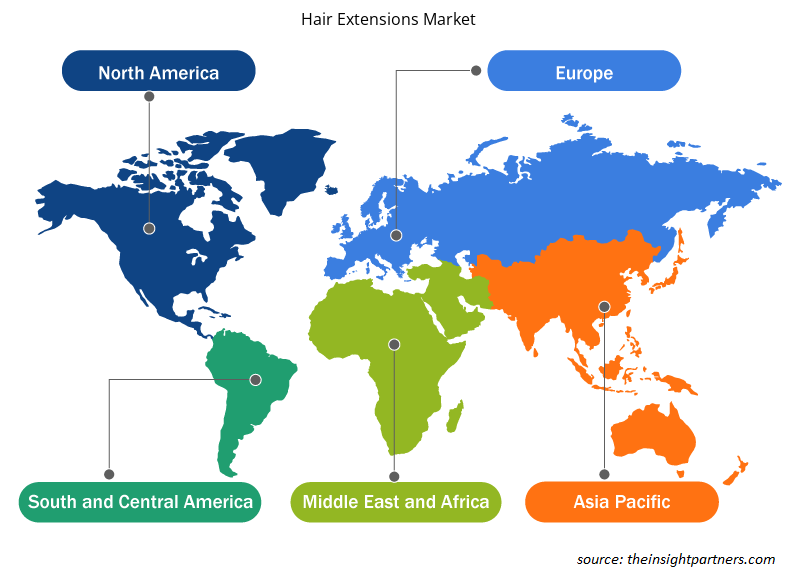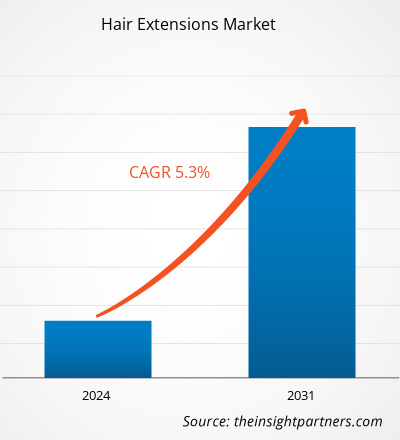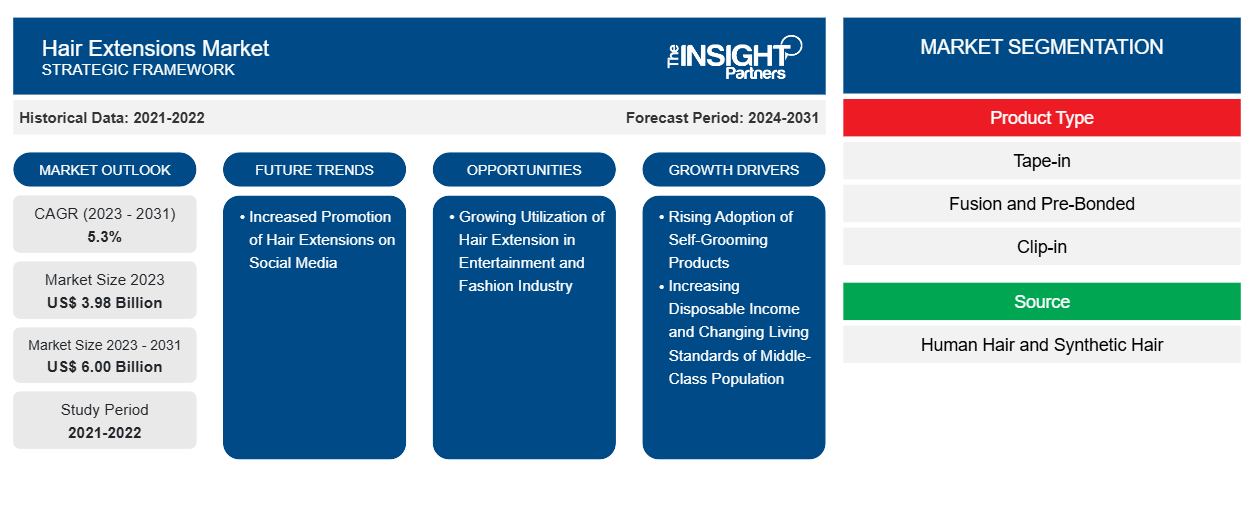Si prevede che la dimensione del mercato delle extension per capelli raggiungerà i 6,00 miliardi di dollari entro il 2031, rispetto ai 3,98 miliardi di dollari del 2023. Si prevede che il mercato registrerà un CAGR del 5,3% nel periodo 2023-2031. È probabile che la promozione crescente delle extension per capelli sulle piattaforme dei social media con strutture di acquisto integrate e sponsorizzazioni di marchi su Instagram, Facebook e YouTube rimangano tendenze chiave nel mercato delle extension per capelli
Analisi del mercato delle estensioni dei capelli
Un graduale spostamento dei consumatori verso prodotti di lusso e di alta qualità per la cura della persona, effetti positivi della cura personale sull'autostima e l'interazione sociale, miglioramento della qualità della vita e crescente incidenza della caduta dei capelli spingono la crescita del mercato delle extension per capelli. La crescente domanda di extension per capelli nei settori della moda e dell'intrattenimento dovuta alla crescente preferenza per le extension per capelli tra modelle e celebrità dovrebbe aprire potenziali opportunità per il mercato nei prossimi anni.
Panoramica del mercato delle extension per capelli
Le extension per capelli sono principalmente realizzate con capelli umani o sintetici di lunghezza, volume e colore variabili. Sono personalizzabili in base alle esigenze dei clienti e vengono ulteriormente acconciate da un parrucchiere. Durante l'applicazione delle extension, la consistenza originale dei capelli non viene alterata. Queste offrono una soluzione rapida per aggiungere volume e far sembrare i capelli più lunghi e folti senza la necessità di sottoporsi a una dolorosa procedura di trapianto di capelli. Pertanto, con l'aumento del reddito disponibile e il miglioramento degli standard di vita, insieme al fiorente settore della vendita al dettaglio di moda, si prevede che il mercato delle extension per capelli continuerà a prosperare nei prossimi anni.
Personalizza questo report in base alle tue esigenze
Riceverai la personalizzazione gratuita di qualsiasi report, comprese parti di questo report, o analisi a livello nazionale, pacchetto dati Excel, oltre a usufruire di grandi offerte e sconti per start-up e università
-
Scopri le principali tendenze di mercato in questo rapporto.Questo campione GRATUITO includerà analisi di dati che spaziano dalle tendenze di mercato alle stime e alle previsioni.
Driver e opportunità del mercato delle extension per capelli
Crescente adozione di prodotti per la cura personale per favorire il mercato
Tra i fattori che determinano la crescita del mercato delle extension per capelli rientrano lo spostamento delle preferenze dei consumatori verso prodotti di lusso e di alta qualità per la cura della persona, dovuto all'aumento del reddito disponibile, all'aumento del potere d'acquisto, al miglioramento dello stile di vita delle persone e alla crescente incidenza della caduta dei capelli.
L'Europa e il Nord America sono mercati significativi per l'industria dello styling, rappresentando oltre il 60% del mercato cosmetico combinato. I prodotti per la cura dei capelli stanno guadagnando un'enorme popolarità tra i consumatori a causa della crescente prevalenza di diradamento dei capelli, secchezza, perdita di volume e altri problemi correlati ai capelli.
I consumatori africani e le persone di discendenza africana sono consumatori significativi di extension per capelli. Gli studi rivelano che le donne africane sono disposte a spendere il doppio in prodotti di bellezza e per capelli. Quindi, la crescente adozione di prodotti per la cura personale tra la popolazione globale guida il mercato globale delle extension per capelli.
Crescente utilizzo delle extension per capelli nei settori dell'intrattenimento e della moda
Le extension per capelli sono ampiamente adottate nei settori dell'intrattenimento e della moda a causa della crescente incidenza dell'alopecia. Inoltre, la domanda di extension per capelli in paesi come gli Stati Uniti è determinata principalmente dalle tendenze delle celebrità. Questo fattore influenza la popolazione generale e sempre più persone richiedono prodotti per extension per capelli. Di recente, Sunny's Hair & Wigs, un negozio al dettaglio, si è espanso a Phoenix e Atlanta da quando ha iniziato a Minneapolis nel 1992. Ha una vasta base di clienti nel settore dell'intrattenimento.alopecia. Further, the demand for hair extensions in countries such as the US is mainly determined by celebrity trends. This factor influences the general population, and more people are demanding hair extension products. Recently, Sunny's Hair & Wigs, a retail store, has expanded to Phoenix and Atlanta since it started in Minneapolis in 1992. It has a vast client base in the entertainment industry.
Le industrie della moda e dell'intrattenimento sono diventate vitali per la vendita e l'adozione di prodotti per extension per capelli. Le case di produzione e di moda hanno in magazzino numerose extension per capelli per modelle e attori, poiché interpretano ruoli e personaggi distinti. L'aumento delle malattie dei capelli tra i consumatori sta anche aiutando l'industria a crescere a un ritmo uniforme. Il numero di individui che soffrono di caduta dei capelli sta aumentando rapidamente, motivo per cui diverse persone stanno scegliendo le extension per capelli. Pertanto, si prevede che tali fattori creeranno opportunità redditizie per la crescita del mercato delle extension per capelli durante il periodo di previsione.
Analisi della segmentazione del rapporto di mercato sulle estensioni dei capelli
I segmenti chiave che hanno contribuito alla derivazione dell'analisi di mercato delle extension per capelli sono tipologia, fonte e canale di distribuzione.
- In base al tipo, il mercato delle extension per capelli è segmentato in tape-in, fusione e pre-legatura, clip-in, trama e altri. Il segmento clip-in ha detenuto la quota di mercato maggiore nel 2023. Le extension per capelli con clip-in, chiamate anche trame clip-in, sono prodotti pronti all'uso e sono le extension meno permanenti in quanto possono essere facilmente rimosse e applicate quando necessario. Le extension per capelli con clip-in di solito richiedono 5-15 minuti per essere applicate a casa. Queste sono le extension per capelli meno dannose e non hanno sostanze chimiche, pressione , calore o altri metodi di installazione. Pertanto, vantaggi come la facile applicazione delle extension per capelli con clip-in e un minor danno ai capelli naturali spingono la domanda di extension per capelli con clip-in.pre-bonded, clip-in, weft, and others. The clip-in segment held the largest market share in 2023. Clip-in hair extensions, also called clip-in wefts, are ready to use products and are the least permanent extensions as these can be easily removed and applied whenever needed. Clip-in hair extension usually takes 5–15 minutes to apply at home. These are the least damaging hair extensions and do not have chemicals,
- In base alla fonte, il mercato è diviso in capelli umani e capelli sintetici. Il segmento dei capelli sintetici ha detenuto una quota maggiore del mercato nel 2023. Le extension di capelli sintetici sono più economiche delle extension di capelli umani, il che dovrebbe aumentare la domanda di extension di capelli sintetici. Inoltre, la disponibilità di un'ampia varietà di colori, stili e lunghezze; la necessità di una bassa manutenzione; e un tempo di applicazione inferiore delle extension di capelli sintetici ne alimentano la domanda.
- In termini di canali di distribuzione, il mercato è segmentato in supermercati e ipermercati, negozi specializzati, vendita al dettaglio online e altri. Il segmento dei negozi specializzati ha detenuto una quota significativa del mercato nel 2023. I negozi specializzati hanno esperti di extension per capelli e offrono servizi personalizzati. Gli specialisti di extension per capelli nei negozi sono formati per valutare le esigenze individuali, consigliare prodotti adatti e fornire servizi di installazione e manutenzione professionali. Questo livello di competenza infonde fiducia nei clienti, garantendo un risultato migliore e riducendo il rischio di danni o applicazioni errate.
Analisi della quota di mercato delle estensioni per capelli per area geografica
L'ambito geografico del rapporto sul mercato delle extension per capelli è suddiviso principalmente in cinque regioni: Nord America, Asia Pacifico, Europa, Medio Oriente e Africa, Sud e Centro America.
Il Nord America ha dominato il mercato delle extension per capelli nel 2023. La domanda di extension per capelli in Nord America è aumentata a causa delle crescenti tendenze della moda delle celebrità e delle elevate attività di cura della persona e bellezza. I consumatori caucasici di solito usano prodotti per capelli per motivi estetici o per creare un'immagine di moda specifica. I consumatori caucasici provengono principalmente dal Nord America e dall'Europa e generalmente hanno redditi più alti rispetto ai clienti di altre regioni. Prestano anche maggiore attenzione alla qualità dei loro prodotti per capelli, il che aumenta la domanda di prodotti per capelli umani. L'aumento della caduta dei capelli è un altro fattore importante che aumenta la crescita del mercato delle extension per capelli. I consumatori in Nord America si concentrano principalmente sull'uso di forme avanzate di extension per capelli. I produttori nella regione stanno investendo molto nella ricerca e nello sviluppo di extension per capelli, il che dovrebbe aumentare il suo mercato in Nord America. Negli ultimi 15 anni, Cinderella Hair è stata all'avanguardia nell'innovazione delle extension per capelli pre-incollate, fornendo la cuticola più fine 100% capelli umani Remy.
Approfondimenti regionali sul mercato delle extension per capelli
Le tendenze regionali e i fattori che influenzano il mercato delle extension per capelli durante il periodo di previsione sono stati ampiamente spiegati dagli analisti di Insight Partners. Questa sezione discute anche i segmenti e la geografia del mercato delle extension per capelli in Nord America, Europa, Asia Pacifico, Medio Oriente e Africa e Sud e Centro America.

- Ottieni i dati specifici regionali per il mercato delle estensioni dei capelli
Ambito del rapporto di mercato sulle estensioni dei capelli
| Attributo del report | Dettagli |
|---|---|
| Dimensioni del mercato nel 2023 | 3,98 miliardi di dollari USA |
| Dimensioni del mercato entro il 2031 | 6,00 miliardi di dollari USA |
| CAGR globale (2023-2031) | 5,3% |
| Dati storici | 2021-2022 |
| Periodo di previsione | 2024-2031 |
| Segmenti coperti |
Per tipo di prodotto
|
| Regioni e Paesi coperti |
America del Nord
|
| Leader di mercato e profili aziendali chiave |
|
Densità dei player del mercato delle extension per capelli: comprendere il suo impatto sulle dinamiche aziendali
Il mercato delle extension per capelli sta crescendo rapidamente, spinto dalla crescente domanda degli utenti finali dovuta a fattori quali l'evoluzione delle preferenze dei consumatori, i progressi tecnologici e una maggiore consapevolezza dei benefici del prodotto. Con l'aumento della domanda, le aziende stanno ampliando la propria offerta, innovando per soddisfare le esigenze dei consumatori e capitalizzando sulle tendenze emergenti, il che alimenta ulteriormente la crescita del mercato.
La densità degli operatori di mercato si riferisce alla distribuzione di aziende o società che operano in un particolare mercato o settore. Indica quanti concorrenti (operatori di mercato) sono presenti in un dato spazio di mercato in relazione alle sue dimensioni o al valore di mercato totale.
Le principali aziende che operano nel mercato delle extension per capelli sono:
- Serrature e obbligazioni
- Klix Capelli Inc
- Easihair Pro.
- Balmain Hair Group BV
- Grandi lunghezze SpA
- Gruppo di prodotti Evergreen Ltd
Disclaimer : le aziende elencate sopra non sono classificate secondo un ordine particolare.

- Ottieni una panoramica dei principali attori del mercato delle estensioni per capelli
Notizie e sviluppi recenti sul mercato delle extension per capelli
Il mercato delle extension per capelli viene valutato raccogliendo dati qualitativi e quantitativi dopo la ricerca primaria e secondaria, che include importanti pubblicazioni aziendali, dati associativi e database. Di seguito sono elencati alcuni degli sviluppi nel mercato delle extension per capelli:
- Diva Divine Hair, il primo rivenditore premium di extension e parrucche per capelli in India dal 2008, ha lanciato una nuova gamma di prodotti economici e di qualità premium come extension con clip, toupet, parrucche e accessori per capelli. I prodotti offerti da Diva Divine sono realizzati al 100% con capelli umani naturali. L'azienda ha rivelato che le sue extension con clip sono facili da usare e forniscono lunghezza e volume istantanei ai capelli. Ha anche menzionato che i suoi toupet sono disponibili in varie forme e dimensioni e che le parrucche sono facili da applicare e donano un aspetto naturale. (Fonte: Hindustan Times, Newsletter, luglio 2022)
- L'azienda di extension per capelli Bellami ha lanciato Bellami Professional Hair Care, la prima collezione al mondo di prodotti per la cura delle extension per capelli di qualità professionale, da utilizzare in salone e a casa. (Happi, Newsletter, ottobre 2023)
Copertura e risultati del rapporto sul mercato delle estensioni per capelli
Il rapporto "Dimensioni e previsioni del mercato delle estensioni per capelli (2020-2031)" fornisce un'analisi dettagliata del mercato che copre le seguenti aree:
- Dimensioni e previsioni del mercato delle extension per capelli a livello globale, regionale e nazionale per tutti i segmenti di mercato chiave coperti dall'ambito
- Tendenze del mercato delle extension per capelli e dinamiche di mercato come fattori trainanti, limitazioni e opportunità chiave
- Analisi dettagliata delle cinque forze PEST/Porter e SWOT
- analisi di mercato delle estensioni per capelli che copre le principali tendenze del mercato, il quadro globale e regionale, i principali attori, le normative e i recenti sviluppi del mercato
- Analisi del panorama industriale e della concorrenza che copre la concentrazione del mercato, l'analisi della mappa di calore, i principali attori e gli sviluppi recenti per il mercato delle extension per capelli
- Profili aziendali dettagliati
- Analisi storica (2 anni), anno base, previsione (7 anni) con CAGR
- Analisi PEST e SWOT
- Valore/volume delle dimensioni del mercato - Globale, Regionale, Nazionale
- Industria e panorama competitivo
- Set di dati Excel
Report recenti
Rapporti correlati
Testimonianze
Motivo dell'acquisto
- Processo decisionale informato
- Comprensione delle dinamiche di mercato
- Analisi competitiva
- Analisi dei clienti
- Previsioni di mercato
- Mitigazione del rischio
- Pianificazione strategica
- Giustificazione degli investimenti
- Identificazione dei mercati emergenti
- Miglioramento delle strategie di marketing
- Aumento dell'efficienza operativa
- Allineamento alle tendenze normative























 Ottieni un campione gratuito per - Mercato delle extension per capelli
Ottieni un campione gratuito per - Mercato delle extension per capelli